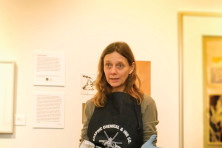Big Art
- Share
- Tweet
- Pin
- Share

In a rented studio space on the second floor of the Peninsula Art School, Ginnie Cappaert has completed her finishing touches on an abstract, cold-wax painting that is 5 feet by 7 feet. Paintings this size are rarely seen in Door County galleries because they would crowd out other works, and few artists have the space to create such large paintings in their own studios.

After being featured in Chicago City Life magazine (the publisher, Pam Berns, is a painter originally from Sister Bay), Cappaert got a call from a Chicago woman who commissioned a painting for her home in Sarasota, Florida.
“Working big is much more physically exhausting – and exhilarating,” said Cappaert. “But a sense of freedom sets in because you are not confined by a smaller canvas.”
Painters like working big but they understand the constraints, especially the market constraints. Big paintings cost more and the number of people who have the money to buy a large work, and the space to hang it, is limited.
“You have to find a client who has that kind of money to spend on a big piece,” said Mary Ellen Sisulak at Turtle Ridge Gallery in Ellison Bay.
Sisulak created mixed-media paintings, often on leather, with stones and pieces of wood.
That required custom wood settings, called “cradles,” customized with indentations to hold the stones and twigs.
“It can weigh a lot, and you need room to stand back from it [to view the whole work] and that can be challenging,” she said.
She is working on a commission that will be 50 inches by 70 inches.
“It takes a lot more concentration, and a lot of planning, she said – but the effort was worth it. “You can express so much more in a large piece; it is such an impactful thing. It is a huge leap of faith. But the other thing is, if people know you can work that large, there are all types of corporate art that is also purchased, and public art. If you can work that big, it opens more options.”

For Emmett Johns of Fish Creek and Albuquerque, the Ameriprise office near Lambeau Field in Green Bay provided a venue. His 7-by-12 abstract painting is in the lobby, and a 10-by-10 piece is down a hall, he said.
“I did those in 2000 and rented the barn at Fish Stock in the autumn when their music was finished,” he said. “I painted my head off; it probably took three weeks. It got so cold I borrowed a big blower heater from a farmer who also provided scaffolding that I needed to work on the paintings.”
The challenges don’t end when a big painting is completed. Last summer, Johns sold an abstract painting, “Helsinki,” that was 70 inches by 52 inches. He made it to hang on one of the huge walls in Fish Creek’s Mr. Helsinki restaurant, now Shiny Moon Cafe.
A Chicago visitor saw it in Johns’ Fish Creek Gallery and when the visitor got home he asked Johns to email him an image for a second look. Then he bought it.
“I had to use Tony Staroska’s truck to take it down to Pack and Ship in Sturgeon Bay,” Johns said – where they crated it and sent it for $700. Cappaert will use an art specialist shipper based in North Carolina to pick up her big painting for the trip to Sarasota.
Getting a painting to its new owner isn’t the only challenge with large art works. Sarah Zamecnik, executive director of the Hardy Galley, said pricing can also be a disadvantage for artists who work big.
“We had the artist Shar Coulson in a group show of big paintings several years ago,” Zamecnik said. “Her large works were stunning in person, but with a $20,000 price tag. If you’re an artist who makes work to sell, then you’re mindful of what the market wants and you make work to accommodate that demand. Shar’s work was priced for the Chicago market.”

Bruce Basch, an artist in Little Sister Bay, has a 6-foot by five-foot painting in his dining area. “It occupies this 12-by-8 wall nicely, and is approaching as big as most collectors can handle in a residential situation,” he said in an email. Submitted. 
Emmett Johns and a 10-by-10 painting he did for American Express, now Ameriprise, for its Green Bay office building. Submitted.
Big paintings also present problems of storage – how many can an artist fit in a studio. Erin LaBonte at Yonder Gallery in Algoma has a creative storage solution: she creates woodcuts and then prints them on fabric.
“I can roll them up and put them aside,” she said. “The biggest will be on display in DePere probably, a five-foot by six-foot collage. I have always worked pretty large.”
LaBonte and her husband, Don Krumpos, have also done huge building-side murals from Fond du Lac to Sturgeon Bay. No storage to worry about there.
“I am not interested in all the small details,” said LaBonte. “I like to be more physical in my work. Scale, like in Margaret Lockwood’s work, draws me in.”
Sandra Martinez also likes physical effort in the large paintings she does on Tyvek (her storage solution is to roll the Tyvek works up around swimming pool noodles). She said it feels completely different to make a large work – it involves more of her body’s range of motion and requires a different cadence – and it’s a completely different experience to view one.
“Viewing a large work makes you move – you are not peering,” Martinez said. “You experience it more as an environment that your body instinctually roams differently. Your head and neck, your whole body, shifts to explore another area in the work.”
She thinks the scale shift for some artists is driven by a desire for museum placement.
“What is powerful in a home at 2 feet by 3 feet is a postage stamp in a museum setting,” she said. “Those 15-foot ceilings are difficult to work with.”
Margaret Lockwood said she has always worked big.

“Bigger than these,” she said, of three 4-by-5 canvases she is painting just off her main gallery space in Sturgeon Bay. “As Mark Rothko might have said, or maybe he didn’t, when you’re making paintings this big you’re just in them.”


